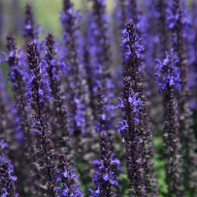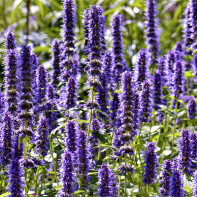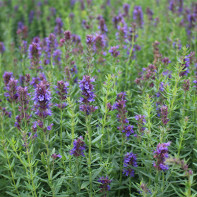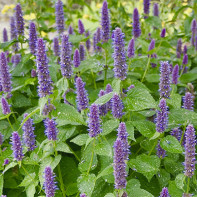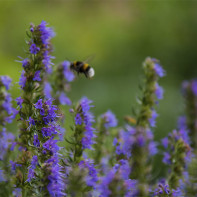Hyssop: medicinal properties and contraindications
Medicinal herbs are often gathered in the wild. But already in the time of Peter I established a medicinal garden, which eventually grew into a luxurious botanical garden. The initiative caught on and almost every housewife has a small and sometimes even a big garden bed where spicy, fragrant and medicinal herbs grow. Often they also perform a decorative function, such as hyssop. It grows beautifully in almost any soil and with minimal watering and care requirements gives a good harvest, providing bed owners with excellent medicinal raw materials for the treatment of many diseases.
- What it looks like and where it grows
- Types of
- Harvesting and storage
- Chemical composition
- Therapeutic properties of the herb hyssop
- For Women
- For Men
- For children
- Hyssop herb in medicine
- Kinds of medicinal compositions with hyssop
- Juice
- Decoction
- Infusion
- Tea
- Alcoholic tincture
- Hyssop oil: properties and uses
- Properties
- Use
- Cosmetic applications
- Hyssop in Cooking
- Pepper stuffed with feta
- Vitamin salad
- Blueberry pie
- How to grow hyssop from seeds
- Contraindications
What it looks like and where it grows
In the wild, hyssop is found in Europe and Asia. It continues to grow on hillsides, choosing rocky, dry areas. But now it is rare to hunt for the medicinal plant in its natural conditions, preferring to grow the fragrant and ornate semi-shrub at home. It began to be cultivated in ancient times. The medicinal properties of hyssop were well known in ancient Greece, using it in medicine, cooking and cosmetology.
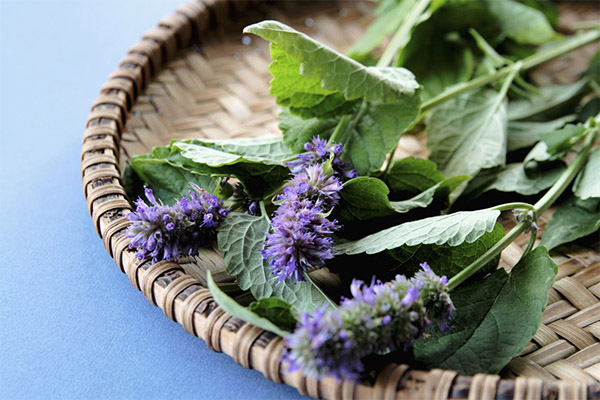
The plant has several names and is referred to as bee-grass or blue St. John's wort depending on the region. Indeed, there is some external resemblance, but experienced herbalists will never confuse these plants. For its wide range of applications it is called a dacha healer and tries to plant it necessarily in the corner of the plot, all the more so because it looks really ornate.
This low shrub reaches a height of 65-70 cm, numerous stems, covered with a strong bark at the base and gradually thinning at the top, grow from a powerful root. Leaves are arranged in tiers, elongated, narrow, with slightly bent inward tips. Flowering begins in July and lasts until September. The color of the flowers is mostly blue, less often there is a lilac or pink hue. Sometimes you can see white flowers, but they are considered an exception to the rule. The bush belongs to perennials, perfectly endures drought and harsh winters, each spring opening fragrant leaves towards the sun. From the leaves and flowers comes a strong spicy fragrance, which deters pests from the garden area and attracts bees. It is often planted around the apiary, gathering medicinal, fragrant honey.
Species
There are few of them, a total of 3 varieties are known.
- Narrow-leaved or medicinal hyssop is most often used for the preparation of decoctions, infusions and teas. Its flowers are gathered in small inflorescences of 8-10 pieces. It is harvested as needed throughout the summer, from the opening of the first buds to the end of flowering, by cutting off the top half of the stems along with the leaves and flowers. Planted in the garden, hyssop lives well in one place for up to 10 years without needing replanting.
- Chalky hyssop is so named for its predilection for soils with high chalk content. It is a rare species, listed in the Red Book. It differs from the ordinary one by its smaller size and lower level of ornamentality. The smell is pungent with a balsamic shade, the inflorescences have a cornflower hue.
- Aniseed is very beautiful in appearance and smells like anise. It is enough to rub the leaf lightly to intensify the smell. It is sometimes called licorice mint for its specific aroma. It can easily be distinguished from other species by the purple spots on the leaves and the height of the stems, reaching 100 cm under favorable conditions. The blue flowers are gathered together in mahogany dense inflorescences, opening gradually, starting from the lower tier, and the bush retains its spectacular appearance until autumn. In cooking, the delicate buds and already blossomed flowers are used and added to salads, giving them a unique spicy flavor.
It's worth considering: The species may over-pollinate when grown together, so it is better to plant them in different segments of the garden plot.
Harvesting and storage
For all varieties, the terms of collection and the principle of preparation are the same. Much depends on the purpose of use. For fresh salads, the leaves and flowers are plucked by hand as needed. For use in decoctions, it is better to start harvesting at the beginning of flowering. If you plan to store the raw material in crushed form, it is better to wait until the height of flowering, when the plant becomes most fragrant.
It is not necessary to select the parts of the hyssop separately. It is enough just to cut the stems and, tying them in a broom, hang them in a shady, well-ventilated place.
Important: Hyssop contains many essential oils. From exposure to direct sunlight during drying and storage they volatilize, reducing the curative properties of the plant several times.
Cooked raw material is stored in linen bags. When grinding herbs is more convenient to put in containers with a tight-fitting lid. The plant in dried form retains its original properties for 2 years.
Chemical composition
In the small narrow leaves and bright inflorescences lies a lot of useful elements. Among them:
- tannins;
- flavonoids;
- organic acids;
- bitterness;
- essential oils;
- glycosides;
- resins;
- gum;
- ascorbic acid;
- alcohols;
- camphene;
- cymol;
- cineol.
The composition includes biologically active substances that allow using the plant as a medicinal agent.
Therapeutic properties of hyssop herb
The title of the dacha healer blue St. John's wort received deservedly. It is used in many folk recipes as an anti-inflammatory, wound-healing, disinfectant. It is also used to get rid of intestinal parasites by brewing it as a tea. The smell is reminiscent of thyme and mint, has a calming effect, relieves excessive irritation, prevents the development of depressive states. A powerful therapeutic effect is achieved in the prevention and treatment of disorders of the central nervous system. Importantly, the pronounced sedative effect of decoctions of hyssop does not cause drowsiness and lethargy. There is an increase in memory, attention, ability to concentrate.
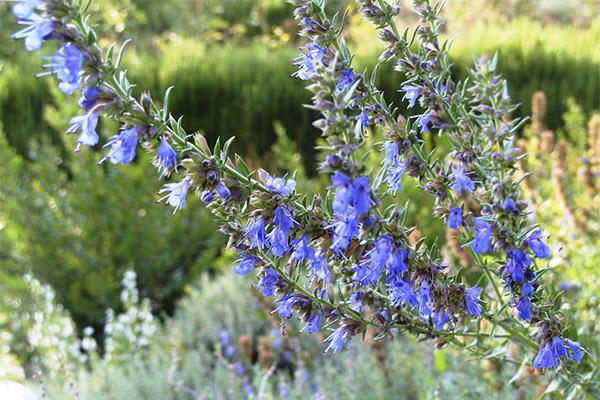
For people suffering from frequent respiratory diseases and bronchitis, hyssop is useful with its antispasmodic action. It dilates blood vessels, eliminates coughs, eases breathing, has an expectorant effect. Essential oils inhaled relieve inflammation, inhibit the development of pathogenic bacteria.
During the course of application of the collection on the basis of hyssop, secretory function of the gastrointestinal tract is adjusted, fermentation of juices increases, a slight laxative effect is manifested, the circulation of bile is adjusted.
Very valued the ability of the plant to accelerate regeneration, stop the reproduction of staphylococcal infection, prevent inflammation of wounds, eliminate abscesses.
Decoctions, infusions and compresses based on hyssop are recommended:
- In diseases of the respiratory system, including asthma and tuberculosis;
- fungal skin lesions;
- Increased emotional excitability;
- hyperhidrosis;
- rheumatism;
- diseases of the genitourinary system;
- frequent colds.
Hyssop combines well with other plant components, honey, licorice root, berries and raspberry leaves.
For women
Decoctions of the herb relieve the acuteness of PMS and menopausal syndrome, improve skin condition, retard age-related changes. Extracts, extracts and essential oil have found their application in cosmetology.
For Men
The plant belongs to natural aphrodisiacs. The remedy is prepared from the flowers and white wine, where 1 tbsp. vegetable raw material is 1 liter of drink. The infusion is kept for 10 days in a dark, cool place. For a full dissolution of essential oils shake the container daily. Take 50 drops 2-3 hours before bedtime.
For children
Recommendations for use are general, the plant is effective for respiratory diseases and inflammatory processes. Children under 12 years of age should not apply blue St. John's wort, unless the foreseeable benefits exceed the possible harms.
Hyssop herb in medicine
The plant is on the list of officially recognized, its properties are well studied. In folk recipes, it is used for the urgent removal of hangover syndrome, eliminates tremors, nausea, returns the ability to think quickly and react adequately to external stimuli. Decoctions are part of the complex therapy for rehabilitation after operations, injuries, large blood losses.

Consumption of the extract in strict doses is practiced to prevent the development of senile dementia. In disorders of the gastrointestinal tract, flatulence, dysbacteriosis decoctions can restore healthy microflora and intensify intestinal peristalsis. Women after 40 years are useful to include herbal teas with hyssop to reduce the intensity of menopausal symptoms.
Recipes
- For coughs, hyssop is brewed in pure form and with the addition of other components. Most often for the preparation for 100 g of dry raw materials take 1 liter of boiling water and 1.5 kg of sugar. First, the herb for 30 minutes, pour boiling water and cover with a towel. Then strain, add sugar and over low heat boiled until syrup. In the finished product is added 1 tbsp. honey. Take 4-5 times a day, 1 tbsp. spoonful of the remedy to thin sputum, relieve spasms and ease breathing. In asthma prepare a decoction without sugar and honey. The proportions and mode of reception are the same.
- With bronchitis, it is very important to regularly eliminate bronchospasm, leading to shortness of breath, difficulty breathing, constant coughing. To prepare a remedy you will need 2 tsp. hyssop for 200 ml of boiling water. Insist the herb for 30 minutes, take 3 times a day for 150-200 ml. It is best to prepare a new decoction each time shortly before taking.
- For allergies, blue St. John's wort is used in the form of an infusion, observing the proportions of 2 tsp. flowers per 1 cup of boiling water. More convenient to make the mixture in a thermos, keeping it there for 2-3 hours. Reception is half a cup 3 times a day.
- With menopause, hyssop is also effective for relieving irritability, insomnia, feelings of unmotivated fear, anxiety. It reduces the frequency and intensity of hot flashes, relieves headaches, improves immunity. Decoction of 5 grams of raw materials in 250 ml of steep boiling water is used. For a sustainable effect, the remedy is taken during the course, 3 times a day, 120 ml of warm water 30 minutes before a meal. The duration of treatment is 2 weeks. Then you need to take a break for 30 days and the course can be repeated.
- To eliminate chronic fatigue syndrome and improve appetite also use decoction. It is prepared from 5 grams of fresh grass and 400 ml of boiling water, soaking in a water bath for 15 minutes. Drink instead of the usual tea half an hour before a meal.
Types of medicinal compositions with hyssop
Blue St. John's wort is used in the form of decoctions, syrups, aqueous and alcoholic infusions, extracts and extracts.
Juice .
It is prepared from fresh raw materials. The herb is passed through a meat grinder, the pulp is squeezed through gauze or a layer of cotton cloth. Used to eliminate hangovers, 40 drops mixed in a glass of water. To reduce sweating, the juice is diluted with water 1:1 and wipe the armpits, feet and hands.
Decoction
It is used most often for external injuries. The ratio of the herb and water is 1 tbsp. per 100 ml. Raw Pour boiling water, 30 minutes in a water bath, then cool to lukewarm and strain. From it make lotions, compresses, wash with cuts, wounds, inflammation, pain in the joints.
Infusion .
Stays no more than 24 hours, so it is recommended to prepare a fresh remedy before each use. Used in problems with the gastrointestinal tract, as a diuretic, strengthening the weakness of the heart muscle. 20 g of dried flowers pour 200 ml of boiling water, soak for half an hour, take 2 times a day.
Tea .
Brewed before use at the rate of 1 teaspoon per glass of boiling water, 5 minutes. You can add raspberries, honey, lemon. Take as a tonic, tonic, antimicrobial during the off-season. Recommended 1-2 cups a day.
Alcoholic tincture
Its advantage is a long shelf life. Fill a half-liter jar with crushed herbs and pour vodka almost to the neck. The container is tightly covered with a lid and put in a dark place for 7 days. The recommended dosage is 30 drops to 5-6 times a day. Tincture can not be used by pregnant, lactating, people with epilepsy or alcohol dependence, children under 12 years of age.
Hyssop oil: properties and uses
The essential components of blue hyssop are very valuable. The cost of the finished product is high, but the benefits justify the money spent. You can buy the oil in pharmacies and most often only on order. Production is very expensive for raw materials, in relation to the original mass yield of oil is only 0.2%.
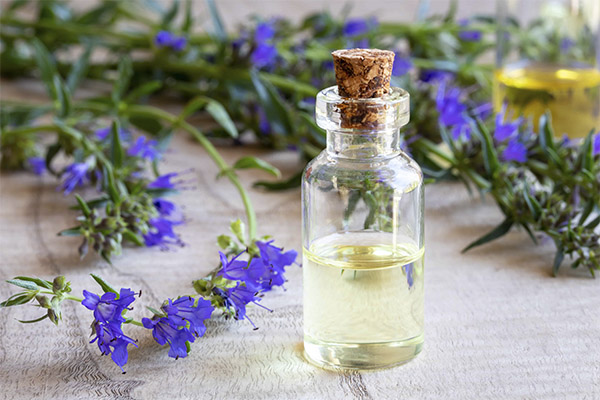
Properties
It is used as an antiviral, tonic, antimicrobial. It can increase physical endurance, stabilize the emotional state, improve digestion, stops inflammatory processes. It also has astringent, anti-rheumatic, antispasmodic, antipyretic, anthelmintic, expectorant action.
Application
The oil is used externally for inflammation, skin and joint diseases. Lotions and compresses are effective for bruises, bruises, superficial injuries of the skin, acne, dermatitis. Essential oil is included in mixtures for aromatherapy, massage compositions, added to the bath, is effective for colds as inhalation. The product is combined with sage, melissa, citrus, geranium, rosemary.
Important: It is forbidden to use the essential oil in high concentration.
Its cosmetic uses
The oil component, extracts and extracts of the plant are introduced into soaps, shampoos, creams and lotions. Decoctions and infusions for washing are indicated for acne, pronounced vascular pattern, dermatitis. Regular use improves complexion, reduces fine lines, accelerates regeneration of micro-damage.
Hyssop in cooking
The spicy taste and bright rich aroma were the reason for the introduction of fresh leaves and flowers in salads, sauces, seasonings. It is part of complex seasonings for meat and fish dishes, pâtés, stuffing, sausages. Some recipes recommend adding it to bean soup, stuffed eggs, sandwiches, pies and dumplings, cutlets and stews.
The rich and tart hyssop is used to create world-famous drinks such as absinthe, Benedictine and Chartreuse liqueurs. Fresh and dried leaves are put in berry tinctures on alcohol and moonshine to enrich the taste, eliminate the smell of horseradish oils.
Among the recipes there are very original and easy-to-make dishes for every day or for special occasions.
Peppers stuffed with feta
For the preparation you will need:
- red bell peppers;
- feta;
- vegetable oil;
- spice mix, which includes oregano, thyme, sesame, hyssop 3-4 grams;
- salt.
Peppers are thoroughly washed, take out the middle along with the seeds. Then bake the billets in the oven until softened and cut in half. Put some feta in each half, then fold the billet in half or wrap it in a tube. Then the halves are carefully laid out on a baking tray, sprinkled with a mixture of spices, salted and returned to the oven for another 10 minutes.
Vitamin Salad
This dish is designed for lovers of unusual flavors, as it combines sliced watermelons, cream cheese, and leeks. Pour the mixture with a sauce of cream, black pepper, anise, fresh leaves and hyssop flowers, chopped herbs with a drop of apple cider vinegar.
Blueberry Pie
Tender shortbread dough is the base, on which the filling of berries is laid. They are mixed with part of the sugar and fresh finely chopped hyssop leaves, which give the mixture a slight spicy tartness and an inexpressible aroma. Bake for half an hour at 180 degrees. The dessert is highly appreciated by adults and children, is easy to prepare, takes little time and does not require special culinary skills. For the base, you can buy a frozen billet of shortbread dough in the store in advance.
There are optimal dosages of spice for different dishes. In soups, add about 0.5 g of dried herb. For side dishes, meat and fish dishes, desserts and marinades, 0.3 g will be enough. Hyssop combines harmoniously with marjoram, fennel, basil, mint, parsley, dill.
How to grow hyssop from seeds
The plant is undemanding to conditions, and since it is a perennial, it is most often planted by seeds immediately in a permanent place. For this purpose, choose a small elevation in a dry sunny place. In nature it prefers stony hillsides and absolutely does not tolerate close groundwater. In landscape design, it is used in mixed flower beds, when decorating alpine slopes, as borders. Therefore, it is worth looking at the options for decorating the site and combine the pleasant with the useful.
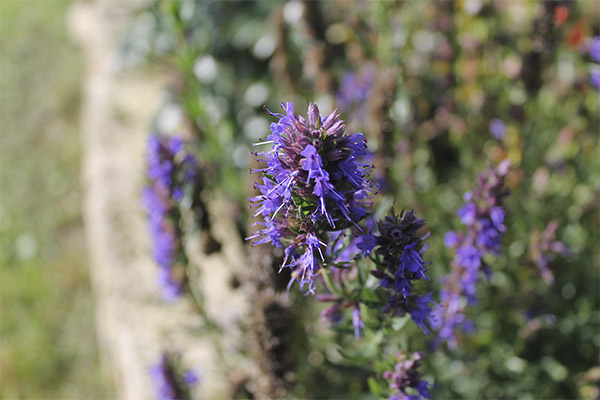
The time of planting is at the end of April and the beginning of May, after the end of night frosts. Seeds are mixed with sand and distributed in shallow furrows. The depth of embedding should not exceed 0.5-1 cm, otherwise the time of sprouting will be delayed for 1-2 weeks. If you sow hyssop in winter, the first leaves will appear as soon as the heat level will be stable at +5 degrees.
No special care is required. It is just worth remembering that it is better to underwater the bush than overwater it. Watering is carried out 3-4 times a season. Special fertilizing is also not necessary. The ancestors of this plant perfectly managed without additional fertilizers, which has been fully transferred to the cultivated species. It is enough to water them with ash solution, sometimes adding nitrogen or complex preparations in the spring in the minimum concentration. If you give them too much, the bush will begin to form excessive green mass to the detriment of flowering.
Pruning should not be neglected. It is carried out during the summer for the preparation of medicinal raw materials and in the fall for better overwintering. It is more convenient to form a rounded outline of the bush. Then the next year it will quickly go into growth.
Sometimes gardeners try to grow blue St. John's wort by sprouts. Then the terms of planting are moved to the end of March. Seedlings break through in 1-1.5 weeks, stretch quickly and require transplanting to a permanent place, so too early they should not be sown in cassettes or peat pots.
In one place the plant successfully develops about 5-7 years, then the soil is impoverished, the bush becomes too big, it needs transplanting. At the same time it is necessary to divide the plant into several parts for its rejuvenation. Many gardeners try to plant several bushes near the porch, under the windows or in the recreation area. The secret is simple - the smell is so specific to insects that even mosquitoes and flies can not stand it, flying around the bushes a tenth of the way.
Contraindications for use
The plant has special properties that impose certain restrictions on its use in food or as a medicine. Decoctions and infusions of hyssop should not be given to pregnant women, it can provoke a miscarriage. Those who suffer from epileptic seizures, hypertensive people will also have to choose another plant.
Especially sensitive people have blue St. John's wort in high concentrations causes allergies. With frequent seizures, neuropathy, kidney disease and nervous diseases accompanied by loss of consciousness, hyssop can provoke a relapse.
Before using decoctions and tinctures based on hyssop, it is advisable to consult a doctor. Longer than 30 days the course of treatment is not carried out. Then a break is necessarily made for a month.
Fragrant and spectacular hyssop will become a beautiful decoration of the garden and a natural medicine cabinet, which will always be on hand.
«Important: All information on the site is provided for informational purposes only purposes. Before applying any recommendations, consult a health care professional. specialist. Neither the editors nor the authors shall be liable for any possible harm caused by materials."

